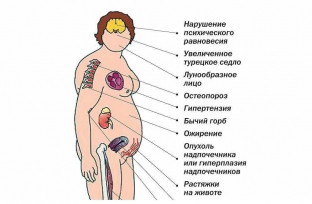Obesity can occur not only as a result of eating a large amount of food, it can be a consequence of a metabolic disorder. The root cause of the change in metabolism is dysfunction of the adrenal cortex. There are two concepts: the disease and Itsenko-Cushing's syndrome, which explain why excess fat appears, how the adrenal glands suffer as a result of the pathology of the hypothalamic-pituitary system.
Itsenko-Cushing's disease is included in the general syndrome named after two scientists – Itsenko and Cushing. In the article, we will consider the symptoms of Itsenko-Cushing's syndrome and the main methods of treatment.
The history of Itsenko-Cushing syndrome, what is the difference from the disease
The first to find the relationship between the nervous system and the adrenal cortex in the development of obesity – this is a neuropathologist and scientist Nikolai Itsenko. He suggested that the cause of the increased secretion of adrenal hormones is a malfunction of the hypothalamus (the area in the brain that is responsible for the relationship between the central nervous system and the endocrine system).
Harvey Cushing was also a neurosurgeon and scientist working on this problem. He suggested that the pituitary tumor was to blame. Both scientists were right, and malfunctions of the pituitary and hypothalamus lead to an increase in the production of hormones in the adrenal glands (corticosteroids).
Illness Itsenko-Cushing (hypercorticism) is an increase in the production of hormones by the adrenal glands due to disorders of the central nervous system and the endocrine system. It differs from the syndrome under the same name in that hypercortisolism is included in the symptoms of Itsenko-Cushing's syndrome.
What does Itsenko-Cushing syndrome include:
- Itsenko-Cushing's disease;
- ACTG – increase in the amount of adenocorticotropic hormones;
- adrenal tumors: adenoma, adenomatosis and adenocarcinoma.
Causes of Itsenko-Cushing's syndrome
- Long-term use of drugs that contain glucocorticoid hormones. Such hormonal drugs can be prescribed for the treatment of lupus erythematosus, bronchial asthma, arthritis.
- Ectopic production of the hormone ACTH – when the tumor can provoke additional production of the hormone. These can be lung, thyroid, or pancreatic tumors.
- When an adenoma occurs, the adrenal cortex begins to secrete a large amount of hormones.
- For pituitary adenoma.
The disease and also the general concept of Itsenko-Cushing's syndrome are most often found in women of productive age (from 20 to 40 years). It can also develop in women after pregnancy and childbirth. Men also suffer from this disease, but very rarely.
Symptoms of Itsenko-Cushing's disease
The disease proceeds brightly and makes itself felt in several areas, so the doctor can easily identify the symptoms of the disease or Itsenko-Cushing's syndrome. When a disease develops in the body, the first thing that happens is that the adrenal and pituitary glands increase in volume.
Itsenko-Cushing syndrome: main symptoms
- specific signs of obesity: fat accumulates in the abdomen and thighs, on the forearms, mammary glands, face and back. The limbs remain thin, which gives the impression of "incomplete" obesity and disproportions;
- changes in the skin: the skin becomes dry, in some places there is increased sweating, may be covered with spots;
- hair growth in women increases according to the male pattern;
- reproductive function is impaired, both in men and women;
- women experience irregular menstruation, decreased libido in both partners;
- muscle weakness;
- blood pressure rises, immunity decreases;
- appear stretch marks on the skin, especially on the face – purple or pink stripes;
- sleep may be disturbed, depression; appears
- the work of the kidneys and bladder is disturbed.

How to treat Itsenko-Cushing's syndrome
When a doctor confidently diagnoses Itsenko-Cushing's syndrome (or disease), prescribes medication or surgery. In addition, radiation therapy may be used. To identify this disease, it is necessary to carry out such diagnostic methods: urine and blood tests, radiography and tomography, hormonal tests.
Surgical intervention is used for pituitary adenoma: adenomectomy – This is a neurosurgical operation, which is the removal of a pituitary adenoma of one of the adrenal glands. Such surgery usually ends in complete recovery and accounts for 80% of cases of remission, and only 10% may experience relapses.
If, in addition to the adenoma, other symptoms appear, medical treatment with drugs is prescribed to establish the menstrual cycle, resume the functioning of the genitourinary system, and normalize blood pressure.






Add a comment